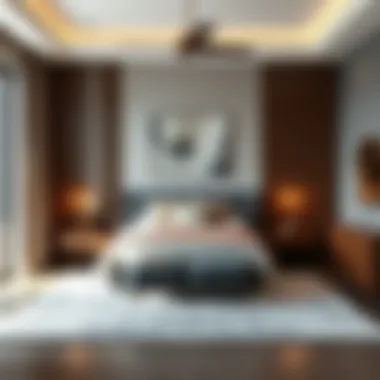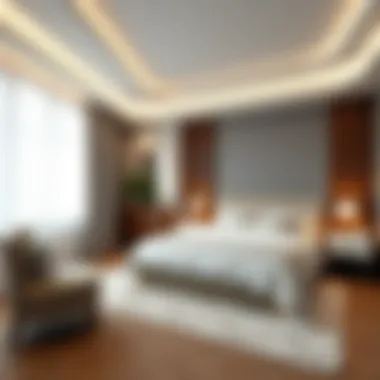Elegant and Functional Simple Bedroom Design Guide


Intro
When you step into a bedroom, what do you notice first? Is it the way the light dances on the walls, or perhaps the inviting arrangement of furniture that beckons you to unwind? The character of a bedroom springs from a delicate interplay of design elements that strive for both elegance and functionality. In this exploration of simple bedroom design, we embark on a journey to uncover principles that guide the creation of serene spaces, ensuring comfort while embracing a clean, minimalist aesthetic.
In a world where life's chaos can infiltrate the home, simple bedroom design serves as a sanctuary. It embodies a philosophy that values clarity over clutter, focusing on what truly matters. This article aims not just to inform but to equip readers with the knowledge and insights necessary to curate a bedroom that reflects personal style while meeting practical needs. Interested in tapping into that potential? Let's delve deeper.
Understanding Simple Bedroom Design
In the realm of home decor, the bedroom stands as a sanctuary. Understanding simple bedroom design forms the cornerstone for creating a space that is not only visually appealing but also practical. At its heart, simple design emphasizes a harmonious balance between elegance and functionality. This concept challenges the notion that beauty must be complex and encourages a return to the fundamentals, laying the groundwork for a serene living area.
The benefits of grasping the nuances of simple bedroom design are manifold. For one, it cultivates a calming atmosphere, reducing the cognitive load of clutter and chaos. Simplicity promotes ease of maintenance, making it easier to keep the space organized and tidy. In today's fast-paced world, where stress levels can often rise, having a simplified haven is invaluable.
Defining Simplicity in Design
Simplicity in design can often be misconstrued as an absence of elements or a lack of personality. However, it's more nuanced than that. Essentially, defining simplicity involves stripping away the unnecessary while still allowing for expression and individuality. It’s about selecting a few well-chosen elements that resonate with the occupant's taste, rather than overcrowding the space with items that do not serve a distinct purpose.
Simplicity can manifest in various forms, whether through the use of lines, shapes, or colors. A straightforward geometric shape for a bed frame or a neutral color palette can speak volumes of elegance without overwhelming the senses. Thoughtfully chosen decorative pieces, such as a minimalist art print or a textured throw blanket, add character without creating visually chaotic impressions.
Importance of Minimalism
The principles of minimalism intertwine closely with simple bedroom design, offering a guiding philosophy that champions clarity and intention. Minimalism encourages us to only keep what we truly need and appreciate. By applying this mindset, homeowners can attain a more purposeful arrangement within their bedrooms.
Adopting minimalism doesn't just declutter the physical space; it's also a practice in mental decluttering. Fewer distractions mean less visual noise, allowing the mind to unwind. It plays an essential role in enhancing overall well-being. According to principles outlined by experts, incorporating aspects of minimalism can reduce anxiety and provide a comforting space for rest and rejuvenation, proving that less really can be more.
Key Principles of Bedroom Design
When it comes to designing a bedroom, understanding the key principles becomes imperative. It’s not just about slapping some paint on the walls or picking out a bed. A well-designed bedroom is a sanctuary, a space that must resonate with both beauty and practicality. The principles distilled into this section have been crafted to help you navigate the delicate balance of aesthetics, functionality, and comfort. Having a firm grasp of these principles ensures that your bedroom not only looks good but also serves its purpose effectively.
Functionality Over Aesthetics
Functionality should take precedence in your bedroom design. This isn't to say aesthetics don’t matter. After all, we want our bedrooms to be visually pleasing. However, when the rubber meets the road, the room must fulfill its basic functions. Think about how you use the space daily.
- Consider daily activities: Do you read before bed? If so, ensure you've got a cozy nook with ample lighting for that.
- Movement flow: Can you comfortably navigate from your bed to the closet? A tight squeeze isn’t just annoying; it disrupts your daily rhythm.
- Storage Needs: Every bedroom needs a tidy-up factor, and achieving that often comes down to the right storage solutions. Opt for beds with built-in drawers or unique shelving that can disguise your clutter while still being trendy.
It's about making every piece count toward enhancing your daily experience without making compromises solely for the sake of appearance.
The Role of Space Planning
Space planning is the backbone of any successful bedroom design. Without a solid plan, even the most beautiful pieces can feel chaotic. Think of it like a game of Tetris; you want every piece to fit snugly together without leaving awkward gaps.
- Measure your space: Before bringing in any furniture, take the time to accurately size up your room. Note down window placements, built-in wardrobes, and other architectural features.
- Zone your areas: Consider dedicating specific areas for distinct activities. A reading nook might require a cozy chair in one corner while having the workspace organized in another. This approach fosters a seamless transition between different functions, enhancing your stay in the bedroom.
- Furniture Arrangement: Positioning your furniture wisely can open up the room, making it feel less cramped. Don’t just push everything against the wall. Engage with the space; perhaps placing the bed diagonally can create an inviting feel.
Effective space planning can dramatically increase how functional and breathable your bedroom feels, making all the difference in how you interact with the space.
Creating Visual Balance
Creating visual balance is like walking a tightrope in design—too much weight on one side can disrupt harmony in the room. The goal here is for the eye to flow through the space without being distracted or overwhelmed.
- Symmetry vs. Asymmetry: Both have their places in design. A symmetrical layout can feel calming, while an asymmetrical arrangement can inject a bit of energy into the space. Play around with different elements and find what feels best for you.
- Layering Elements: Mix up texture and shape to keep things interesting. For instance, if you have a sleek headboard, consider soft throws and decorative pillows to create a contrast that pleases the eye.
- Focal Points: Every room needs a feature that grabs attention. This could be a standout piece of art or a beautifully made bed. Build on this focal point by arranging other elements around it, ensuring they complement rather than compete.
Remember, the aim is to create a cohesive look that doesn’t exhaust the viewer but instead invites relaxation and comfort—a sanctuary that evokes peace.
“Design is not just what it looks like and feels like. Design is how it works.” – Steve Jobs
Creating a bedroom that aligns with these principles ensures that it’s not just a place to lay your head, but a personal haven crafted with thoughtful consideration.
Color Schemes for Simple Bedrooms
Selecting the right color scheme is crucial in crafting a simple bedroom that captures both elegance and functionality. A well-thought-out palette can significantly influence the mood, perceived space, and overall aesthetic. The colors you choose act like the stage where the rest of your decor can shine, setting the tone for relaxation and tranquility. When designing a bedroom, it's vital to consider colors that promote restfulness while also reflecting personal style. The benefits of a cohesive color palette include improved emotional well-being, a sense of order, and an inviting atmosphere, making it an invaluable aspect of bedroom design.
Neutral Palettes
Neutral palettes form the backbone of simple bedroom design. These colors are like the unsung heroes of home decor, providing a calm backdrop to any space. Soft whites, grays, and beiges create a serene environment, promoting relaxation at the end of a long day. They also serve as a canvas, allowing you to incorporate patterns or textured elements without overwhelming the senses.
Moreover, choosing a neutral palette has practical advantages too. These tones can seamlessly fit into various design styles, from modern to rustic, and can easily adapt to changing decor over time. With the rise of more sustainable living, neutral colors tend to use less dye in their production, making them an eco-friendly choice as well.
Accent Colors


When you think about accent colors, imagine the cherry on top of your favorite dessert. They cannot only enhance the overall structure of the room but inject personality where needed. Accent colors are strategically important as they can draw attention to focal points and highlight details in the architecture or decor. However, choosing them wisely is key.
Choosing Effective Accents
The specific aspect of choosing effective accents hinges on understanding how certain colors work together. Take the time to choose hues that complement the primary neutral tones without clashing. For instance, a bold mustard yellow might work wonders against a backdrop of soft beige. Their contrasting natures create visual interest without stepping on each other's toes. The key characteristic here is to aim for a balance. Something that feels intentional rather than haphazard. More often than not, effective accent colors could mean the difference between a sterile look and a lively space. A well-thought design leaves a lasting impression.
Integrating with Furniture
Now, about integrating those accent colors with furniture—we can't overlook how foundational furniture pieces can either enhance or diminish what you aim to achieve. When selecting furniture, consider items that echo the chosen accents, be it through upholstery or finishes. If your accent color is a deep emerald green, perhaps opt for a bedside table that features that same shade in a subtle detail, or decorative throws in that hue draped over your neutral-colored bed. This creates harmony.
However, it pays to be cautious here. Overdoing it can lead to visual chaos. It's always wise to use accents judiciously. Remember, while bold accents can enhance the overall look, too many bold choices can quickly lead the design astray.
"Incorporating color thoughtfully can transform an ordinary space into a personal sanctuary, where design and comfort coexist harmoniously."
Strategically choosing, implementing, and integrating colors in your bedroom can create a well-balanced environment. The relationships between your chosen palettes and the materials used can not only make or break the vibe of the room but resonate profoundly with its user. Whether you are earning sweet slumber or enjoying a moment with a good book, a well-executed color scheme should make that experience all the more special.
Furniture Selection and Arrangement
Furniture selection and arrangement are pivotal in creating a simple bedroom that balances elegance and functionality. Not only does furniture dictate the look and feel of a space, but the right choices also enhance comfort and practicality. Let's dive into the essentials, multi-functional options, and layout optimization to see how each aspect contributes to a well-designed bedroom.
Essential Furniture Pieces
Bed Frame Options
When talking about bed frames, it's not just about choosing something nice to look at. The bed frame serves as the centerpiece of your bedroom, shaping the overall atmosphere. One popular choice is the platform bed, which provides a sleek, modern look. The key characteristic of these frames is their low profile, giving the illusion of more space. This minimalist style can turn your bedroom into a tranquil retreat.
However, be wary of possible downsides. For instance, platform beds often lack under-bed storage, which might be a concern if space is tight. Still, they shiny silver lining is that they easily accommodate stylish mattresses, making them versatile. With a range of materials from wood to upholstered designs, platform beds are both fashionable and functional by perfectly aligning with the concept of simple bedroom design.
Storage Solutions
In any room, storage is essential, but it's especially crucial in a bedroom where clutter can quickly turn into chaos. A good storage solution often features dual functionality, such as a bed that incorporates drawers underneath or stylish bins that fit neatly in corners. This strategic choice of furniture not only frees up floor space but keeps belongings in check, letting simplicity shine through.
Common characteristics include versatility and innovation. For instance, a chest of drawers may come in a sleek design, minimizing visual clutter and enhancing the space's calmness. However, certain designs can be a bit bulky, so choosing a piece that aligns with the scale of your room is wise. A natural wood finish can also add warmth while having the added advantage of durability.
Multi-Functional Furniture
Example: Murphy Beds
Murphy beds stand out as one of the most clever inventions in space-saving design. The beauty of these beds lies in their ability to fold up and away when not in use, which is perfect for smaller bedrooms or multifunctional spaces. When the bed is tucked away, you can transform the area into a cozy sitting room or workspace.
Their unique feature is the ease with which they can be operated. With a simple pull, the bed comes down, and, with some practice, it can even become second nature. However, potential buyers should note that some models can be more expensive due to their mechanics and quality construction. Regardless, they are a favorite choice for those prioritizing practicality without sacrificing style.
Example: Ottoman Storage
Another example of multi-functional furniture is the ottoman with storage. This piece is often overlooked in terms of its potential utility. It's not just a footrest or a seat; it can cleverly conceal extra linens or magazines, reducing visual clutter. The beauty of ottomans lies in their versatility. You can find them in various styles, materials, and colors, making it easy to match them with your overall theme.
The main advantage is the dual-purpose nature of these items. They are often lightweight and easy to move, meaning they can be adapted for different uses as needs change. On the downside, be cautious about making sure it provides the right amount of storage you require – some smaller models can be a tad underwhelming.
Optimizing Layout
Optimizing layout is about more than just placing furniture in the room. It’s about understanding how space is utilized and how movement flows through it. Consider creating zones: perhaps a sleeping area, a reading nook, and a workspace. This would provide organization and functionality, contributing to a more serene environment.
Focus on the following when optimizing your layout:
- Flow: Ensure there's enough space to walk comfortably without obstacles.
- Proximity: Keeping furniture within a reasonable distance can make a space feel cohesive.
- Light: Positioning furniture to take advantage of natural light sources can also enhance the ambiance of your room.
In sum, furniture selection and arrangement play a critical role in simple bedroom design. They intertwine elegance with functionality, creating spaces that resonate tranquility and invite relaxation.
Incorporating Lighting
Lighting is more than just a functional necessity in a bedroom; it plays a crucial role in establishing the mood, functionality, and overall aesthetic of the space. A well-lit bedroom enhances the visual appeal while ensuring practical activities, like reading or working, can be carried out comfortably. Balancing various light sources and their intensities not just brightens up the room but also creates layers that contribute to a serene environment.
Natural Light Sources
Natural light brings a sense of warmth and openness to any bedroom. Utilizing windows strategically can flood a simple bedroom with sunlight, making it feel larger and more inviting. Not only does sunlight promote positive moods, it also helps with maintaining a healthy circadian rhythm. Key considerations when harnessing natural light include:
- Window Treatments: Opt for sheer curtains or blinds that allow for light diffusion while offering privacy.
- Positioning: When planning the layout, consider the placement of windows. Bedrooms facing east capture morning light, which is energizing, while those facing west bask in the golden hour glow.


"Natural light can transform a space entirely, showing its true character."
Artificial Lighting Techniques
Artificial lighting completes the picture when it comes to bedroom design. Combining different types of lighting can greatly influence both functionality and atmosphere. Here are two techniques to explore:
Layered Lighting
Layered lighting encompasses a mix of ambient, task, and accent lighting. This approach creates depth and variety, allowing for flexibility in how a room is utilized. The key characteristic of layered lighting is that it enhances the functionality of a bedroom by providing adequate illumination for specific tasks while also creating a cozy environment.
A unique feature of this lighting style is its adaptability. For instance, you might have a central ceiling fixture for general lighting, bedside lamps for reading, and wall sconces to highlight artworks. This setup allows various light sources to be dimmed or brightened depending on the time of day or activity. The main advantage here is versatility; as your needs change, so can your lighting.
Smart Lighting Options
Smart lighting options take convenience to a whole new level. These systems can be controlled via remote, smartphone, or even voice commands, ensuring you don’t have to get up to switch off the light. The key characteristic of smart lighting is its ability to adapt to user preferences through features like color change and brightness adjustment. This flexibility makes it a popular choice in simple bedroom design, offering both functionality and style.
One unique feature of smart lighting is the ability to schedule lighting patterns, creating a sequence that mimics natural light progression throughout the day, which is beneficial for sleep hygiene. However, potential disadvantages may include reliance on technology; if there's a power outage or if devices malfunction, your lighting may become less reliable. But overall, smart lighting options provide a modern twist on traditional designs, infusing simplicity with a touch of sophistication.
Textures and Materials
When delving into bedroom design, the textures and materials you choose play a crucial role in shaping the overall atmosphere of the space. They are not just about how things look; they impact how the room feels and functions. A well-thought-out selection of materials can enhance comfort and even promote relaxation within your personal sanctuary. In this section, we will explore how fabrics and finishes can elevate simplicity in design, while also providing practical considerations to keep in mind.
Choosing Comfortable Fabrics
Selecting the right fabrics can make a world of difference in a bedroom setting. Comfort is paramount, especially in spaces meant for relaxation and sleep. It’s wise to consider materials that invite touch. Soft cotton or linen for bedding can help create a gentle, cozy vibe, perfect for unwinding after a long day.
Moreover, curtains made from natural fibers not only look elegant but can also effectively filter light, creating a serene ambiance that encourages tranquility. When choosing fabrics:
- Texture: Think about how the fabric feels against your skin. Some people prefer the soft touch of jersey knit, while others lean toward the crispness of a tailored linen.
- Breathability: Look for materials that allow air circulation. This is especially important for bedding, as it directly impacts temperature control throughout the night.
- Maintenance: Some fabrics may require special care, but choosing machine-washable options can save time and hassle.
Comfortable fabrics lend a tactile quality to your bedroom, making it not just visually appealing, but also a soothing retreat.
Sustainable Material Use
Sustainability has become a critical consideration in design today. Opting for sustainable materials not only benefits the environment but can also add unique character to your bedroom. When considering sustainable options, two notable choices stand out:
Eco-Friendly Fabrics
Eco-friendly fabrics, such as organic cotton, bamboo, or Tencel, are produced with less harmful effects on the planet. They are becoming increasingly popular as consumers seek to make more responsible choices that align with their values.
These fabrics often feature the following key characteristics:
- Biodegradable: Many eco-friendly options break down naturally without leaving harmful residues.
- Non-Toxic: They typically avoid harmful chemicals during production, ensuring a safer environment for you and your family.
- Energy Efficient: The processes used to make some sustainable fabrics consume less energy compared to traditional methods.
However, one must consider that these fabrics may come at a higher initial cost, yet they offer durability and comfort that often proves worth the investment.
Natural Wood Finishes
Natural wood finishes in furniture or decor pieces can significantly enhance the aesthetic of a simpler bedroom design. The appeal lies in their warmth and ability to add character without overwhelming the senses.
Key characteristics of natural wood finishes include:
- Unique Grain Patterns: Each piece of wood has its own distinct patina, which means no two items will ever look the same.
- Durability: Properly finished wood can last for decades, making it a sound long-term investment.
- Sustainability: When sourced responsibly, natural wood can be a sustainable option, particularly if it comes from reclaimed sources.
However, there’s a downside. Wood can be sensitive to humidity and light, which may require periodic maintenance, like refinishing or oiling.
Personalizing Simple Designs
Personalizing simple designs is vital for creating a bedroom that reflects individual taste while maintaining the balance of elegance and functionality. The essence lies in transforming minimalist spaces into personal havens that speak to the occupant's identity. This endeavor not only adds layers of beauty but also encourages an emotional connection to the space, ultimately making it more inviting.
When you think about it, personal touches in a bedroom can make all the difference. Unique items can spark joy and create a sense of comfort that generic decor simply can't match. Therefore, the importance of personalizing designs cannot be overstated.
Incorporating Art and Decor
Selecting Wall Art
Wall art can elevate a bedroom's aesthetic significantly and bring an air of sophistication or tranquility, depending on the choice. A well-selected piece can become a focal point, guiding the viewer’s eyes through the room. For instance, a large canvas depicting a serene landscape can instantly infuse calmness into the space.


The key characteristic of selecting wall art is its ability to resonate with personal experiences or emotions. Art often reflects the homeowner's personality; therefore, choosing meaningful pieces allows a visual narrative of life and interests.
One unique feature of wall art is its versatility. Different textures or techniques—from canvas and prints to wood and metal—contribute contrasting elements within a simple design, enhancing visual interest. However, if overdone, it can clutter the aesthetics, so finding a concise yet profound selection is advisable.
Decorative Accessories
Decorative accessories are like the cherry on top of a well-baked cake; they can significantly enhance the overall design. Items like well-placed vases, unique lamps, or vintage trinkets add layers to a simple theme without overwhelming it. They serve both functional and aesthetic purposes, bringing warmth and character to the space.
The standout characteristic of decorative accessories is their ability to create visual stories. Each object can communicate aspects of the owner's life or aesthetic choice, thus making the bedroom a true reflection of its inhabitant.
One unique feature to consider is the size and scale of these accessories. A large floor vase can make a statement while smaller knick-knacks can fill in voids or add charm. But, too many accessories can lead to chaos and defeat the purpose of a simple design. Thus, a mindful selection process is crucial to maintaining a clean yet personal ambiance.
Plants as Decoration
Plants offer a refreshing way to personalize simple bedroom designs, bridging the gap between nature and human habitation. They not only purify the air but also contribute to a calming atmosphere. Adding greenery can transform an otherwise sterile setting into a lively sanctuary.
When choosing plants, consider low-maintenance varieties like succulents or snake plants for easy upkeep. Plants can also serve as decor on shelves or window sills, interjecting life into spaces that might otherwise feel static. On the downside, it’s important to monitor the condition of these plants—dead foliage can undermine the aesthetics of a room.
Through personalization, the journey of creating a bedroom is one that balances tastes and style within a simple framework.
Personal touches transform mere decor into meaningful expressions of self.
By integrating art, decor, and even plant life thoughtfully, one can curate a cohesive yet personalized environment in their bedroom.
Maintaining Simplicity
Maintaining simplicity in bedroom design is not just a trend; it's a vital philosophy that leads to a tranquil living environment. The essence of a simple bedroom lies in its ability to create a serene space that promotes relaxation and comfort. When the clutter is stripped away, what remains is an inviting atmosphere conducive to good sleep and peaceful waking.
At the heart of simplicity is the notion of functionality. A space that serves its purpose without unnecessary distractions allows for a more enriching life experience. It’s all about peace of mind. The benefits of maintaining ease in your bedroom are many, including reducing stress and promoting positive energy flow. Therefore, embracing simplicity can ultimately enhance your well-being.
To ensure simplicity thrives in your bedroom, consider the following elements:
- Decluttering: Removing items that you no longer need or use creates space and clarity.
- Mindful Items: Choose decor and furniture that are both functional and aesthetically pleasing. Each piece in your room should feel intentional.
- Balanced Design: Opt for furnishings and layouts that encourage openness. This balance allows for a sense of calm, making the space feel more spacious.
Keeping things simple requires consistent effort and awareness. In the coming sections, we dive into practical strategies for decluttering and maintenance that will contribute to your simplicity journey. It's about making choices that serve not just the eye but also the mind and spirit.
"Less is more." This adage rings true in many aspects of life, including our living spaces. Stripping back to essentials can reveal the beauty of simplicity.
Decluttering Strategies
Decluttering is a fundamental step in maintaining simplicity. It involves evaluating what gives you joy, what needs to be utilized, or what might just be taking up space. Here are a few effective strategies you can implement:
- The One-Year Rule: If you haven’t used it in a year, it might be time to part ways. This helps in curating a selection of items that truly matter to you.
- Create Zones: Divide your space into sections and tackle one zone at a time. This makes the task feel manageable and less overwhelming.
- Incorporate the "Two in, One Out" Method: For every new item you bring in, consider letting go of two. This keeps your inventory in check.
Adopting a systematic approach to decluttering results in clearer spaces and a more organized mind.
Regular Maintenance Tips
To keep your bedroom looking and feeling its best, regular maintenance is essential. Here are some tips to ensure simplicity is a long-term commitment:
- Scheduled Cleaning: Dedicate time each week for a mini-clean. This can mean dusting surfaces, washing linens, or organizing any stray items. Setting a specific day each week allows you to build this into your routine.
- Mind Your Storage: Use chic storage solutions that blend seamlessly into your decor. Baskets, boxes, and under-bed storage can keep clutter at bay without compromising style.
- Minimal Upkeep: Stick to fabrics and furniture that require less maintenance. For instance, leather or synthetic materials often respond better to spills than intricate fabrics; this makes life easier.
Staying organized is a bit like tending to a garden; regular care fosters growth and health. With these simple yet effective strategies, your bedroom can remain the serene retreat you desire.
Trends in Simple Bedroom Design
Staying abreast of trends in simple bedroom design is crucial for creating serene, functional spaces. Trends not only reflect modern living but also incorporate evolving lifestyles and preferences. They help homeowners and designers alike to focus on practical solutions while expressing personal style. Knowing what’s in vogue allows one to blend elegance with simplicity, ensuring that bedrooms are both inviting and stylish.
The significance of tracking trends goes beyond mere visual appeal. Understanding current tendencies can influence decisions on color palettes, furniture choices, and even layout optimization. Additionally, trends often intersect with technology and sustainability, which can redefine how a space feels and functions.
Current Design Trends
Current design trends are shifting towards a more holistic approach. Here are a few key elements currently making waves in simple bedroom design:
- Earthy Color Tones: Shades like terracotta, moss green, and sandy beige are gaining popularity. These colors promote a sense of calm, connecting the indoor environment with nature.
- Natural Materials: The use of wood, stone, and organic fabrics is becoming increasingly common. These materials add texture and warmth while aligning with sustainable practices.
- Smart Technology Integration: Smart home devices are now being designed for aesthetics and functionality. From adjustable lighting to climate control, smart features can enhance the overall experience without compromising simplicity.
- Biophilic Design: Incorporating plants and natural elements not only livens up a space but also contributes to mental well-being. More folks are bringing greenery indoors, with potted plants and vertical gardens taking center stage.
- Layered Textures: To avoid a flat look, mixing textures—from plush rugs to smooth linens and rough wooden accents—gives dimension to bedrooms. It’s about creating a tactile experience that engages the senses.
"Design is not just what it looks like and feels like. Design is how it works." - Steve Jobs
These trends underscore a collective yearning for balance in our quick-paced lives, emphasizing a return to comfort and authenticity.
Sustainable Design Choices
Sustainability in design isn’t just a buzzword; it's a necessity in today’s world. More homeowners are conscious of their ecological footprint, influencing choices in furnishings and decor. Here are a couple of sustainable design choices making a difference:
- Eco-Friendly Fabrics: Selecting textiles made from organic cotton, bamboo, or recycled materials helps reduce waste. These fabrics can still be chic while being kinder to the planet.
- Locally Sourced Furniture: Buying from local artisans reduces transportation emissions and supports community businesses. Each piece carries a unique story, integrating local culture into the bedroom space.
- Reclaimed Wood: Using reclaimed wood for furniture or accents not only brings character but also minimizes deforestation. It’s a resourceful way to add some vintage charm without the environmental toll.
- Energy Efficient Lighting: Opting for LED lighting or daylighting strategies can cut energy consumption significantly. Adding smart dimmers can help fine-tune lighting scenarios while saving energy and enhancing ambiance.















